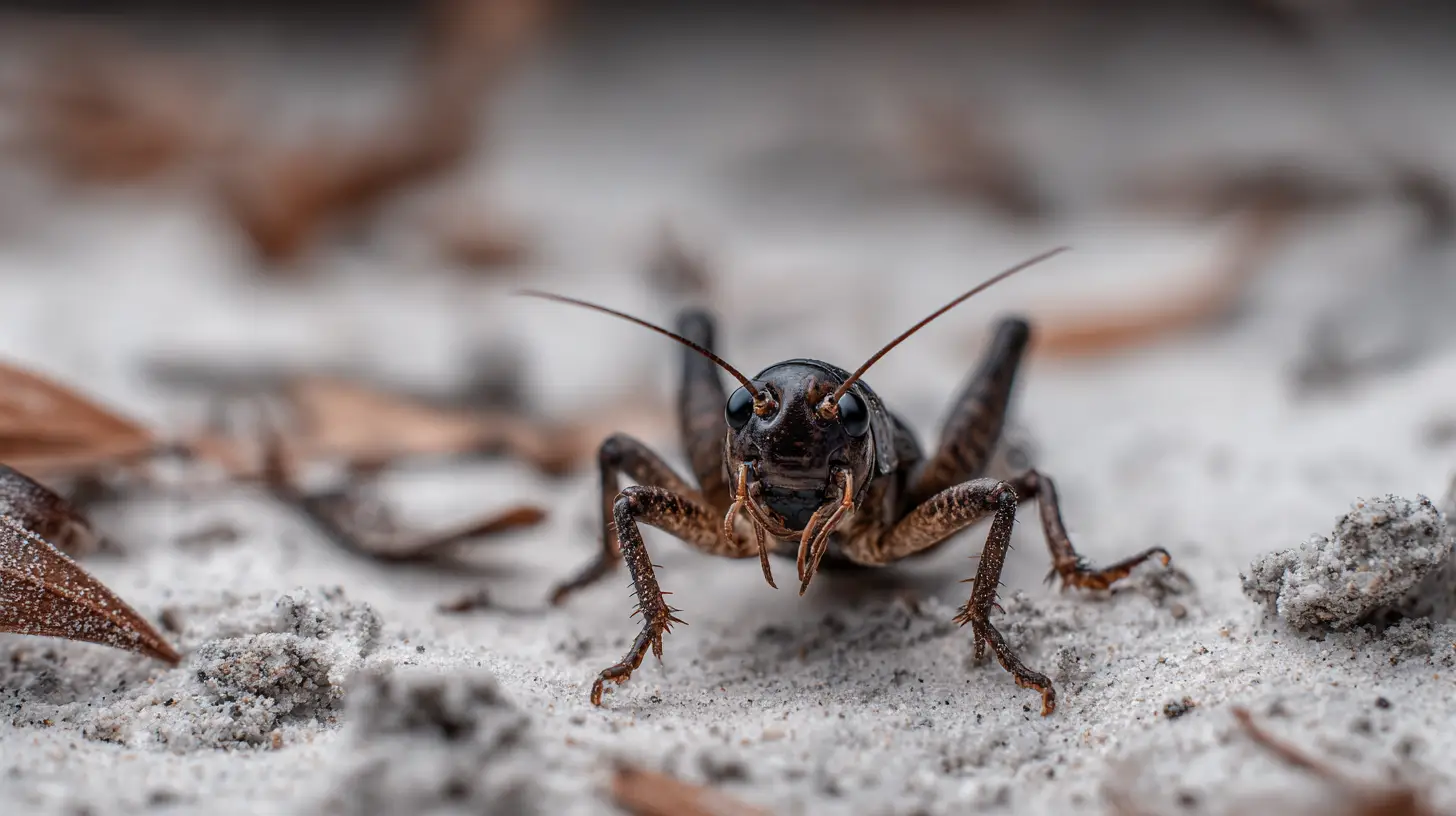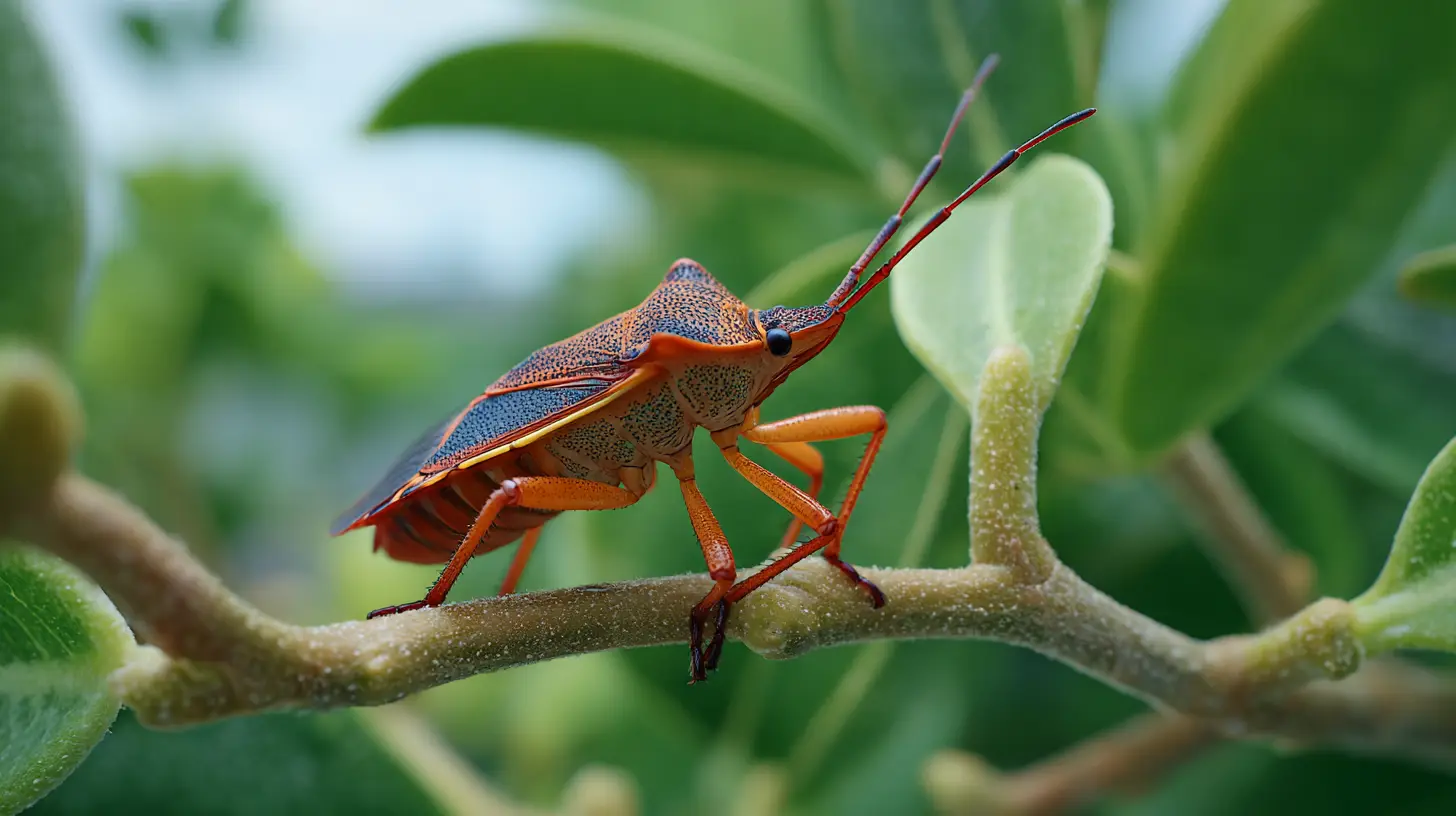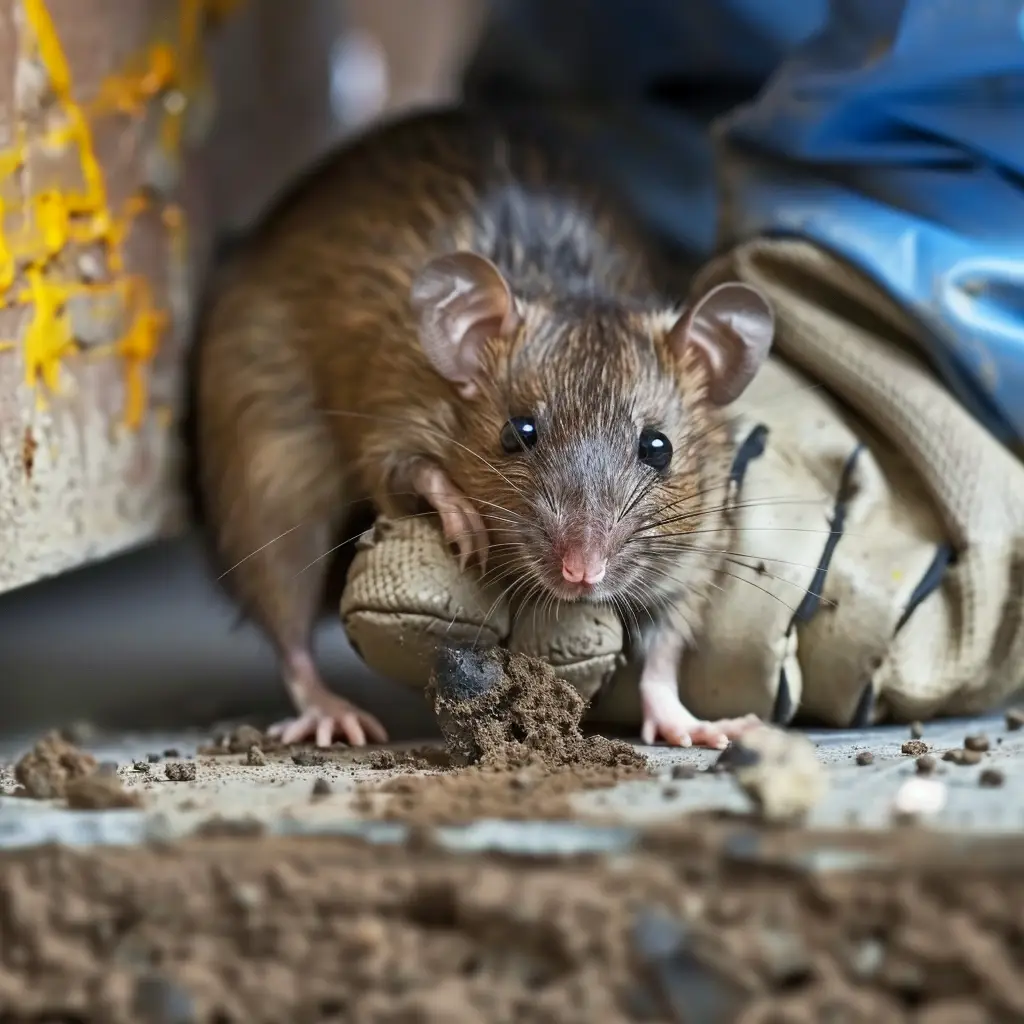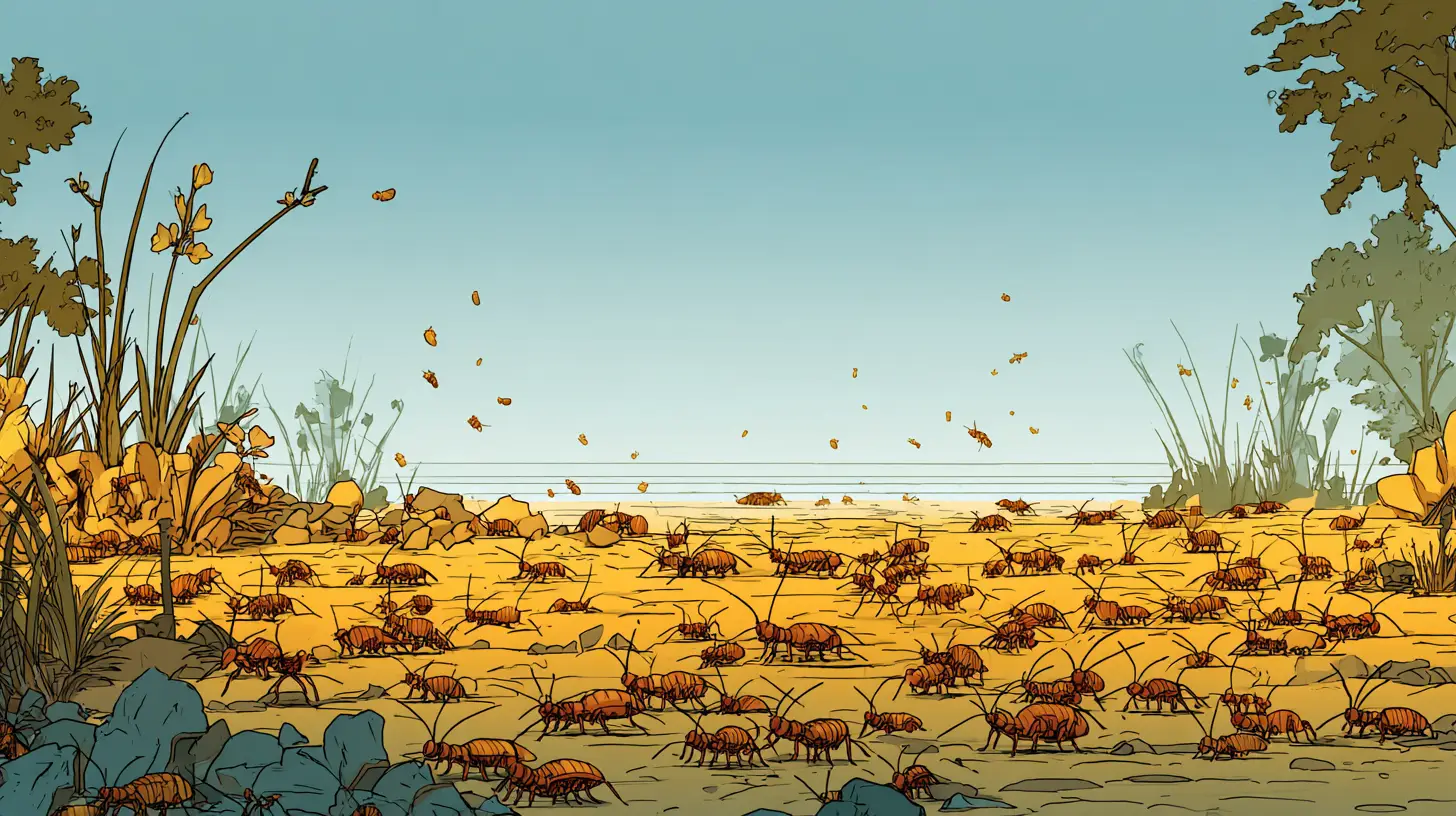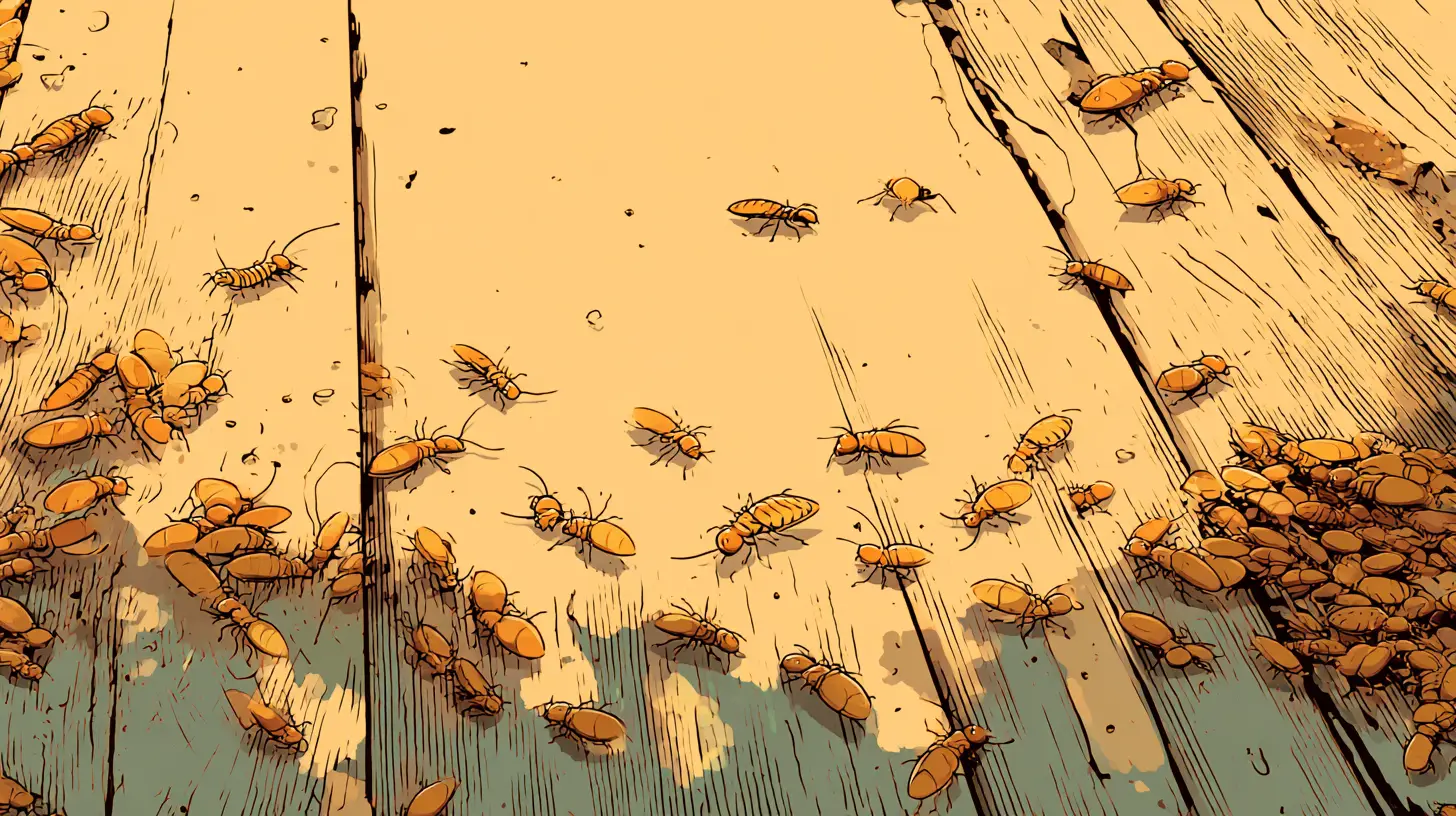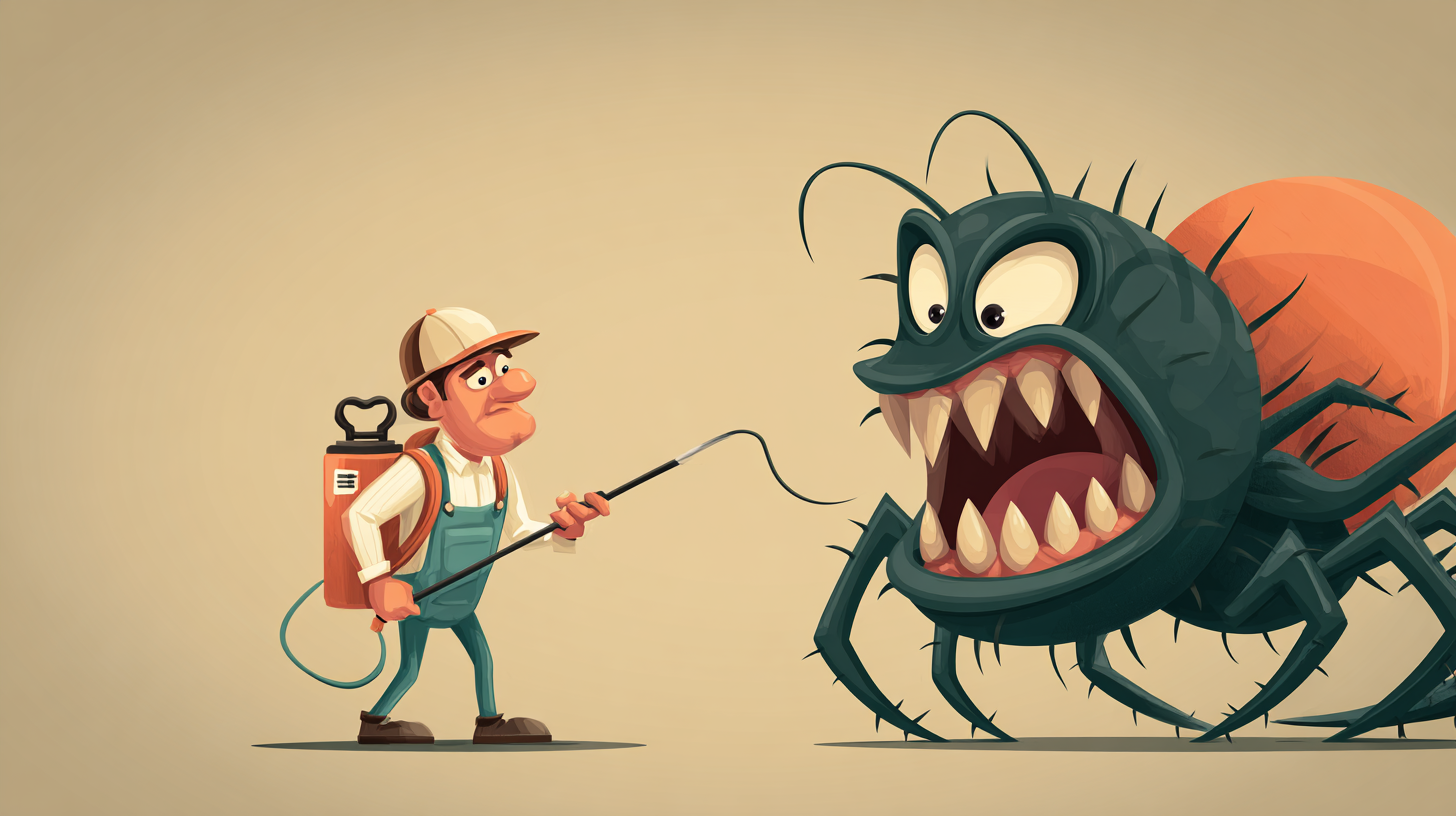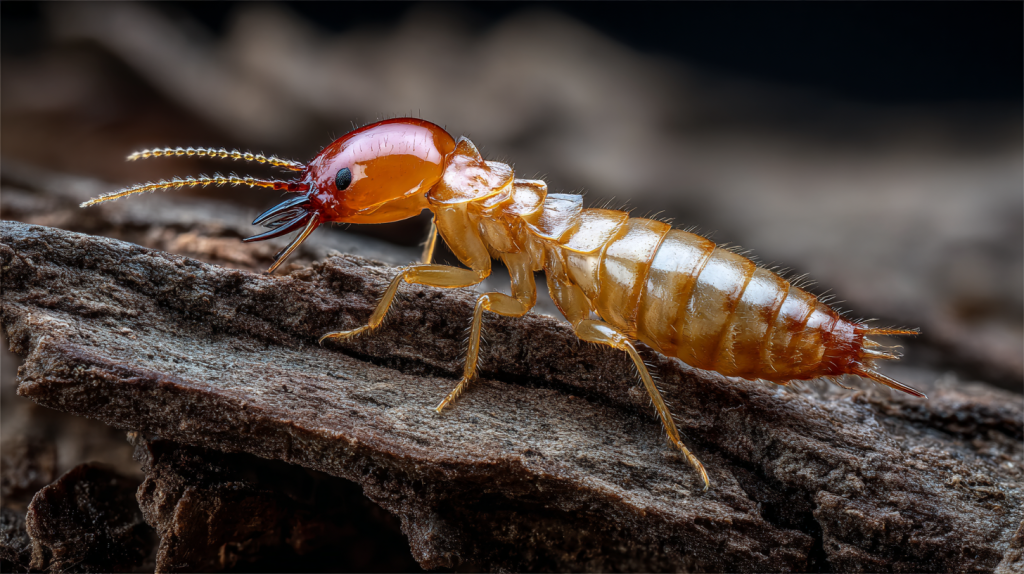
Table of Contents
When most Bradenton homeowners think about termites, they picture the subterranean species that build mud tubes and live underground. But there’s another termite threat that’s potentially even more dangerous because it’s harder to detect: drywood termites that live entirely within the wood of your home, silently eating it from the inside out.
Unlike their soil-dwelling cousins, drywood termites don’t need ground contact or moisture sources. They extract everything they need directly from the wood they’re destroying, which means they can infest any wooden structure in your home – from roof timbers to picture frames – without leaving obvious external signs until the damage is severe.
Bradenton’s warm, humid Gulf Coast climate creates perfect conditions for drywood termites year-round. Florida hosts 20 different termite species – more than any other state – and drywood termites are among the most destructive. For Bradenton homeowners, this means understanding these silent destroyers isn’t just helpful knowledge – it’s essential protection for what’s likely your largest investment.
The challenge with drywood termites is that by the time most people notice signs of infestation, the damage is already extensive and expensive to repair. But with the right knowledge about identification, prevention, and treatment options, you can protect your Bradenton home from these destructive pests.
Let’s dive into everything you need to know about drywood termites in Bradenton – from identifying early warning signs to understanding your treatment options and protecting your home long-term.
Key Takeaways
- Drywood termites are a year-round threat in Bradenton’s warm, humid climate, requiring ongoing vigilance and prevention efforts.
- Early detection saves money because drywood termite damage is expensive to repair and difficult to detect until advanced stages.
- Professional treatment is essential for effective drywood termite control in Bradenton, due to their hidden nature and need for specialized treatment methods.
- Prevention is cost-effective compared to treatment and repair costs, making annual inspections and preventive measures smart investments.
- Multiple treatment options exist but the best choice depends on infestation extent, location, and individual circumstances.
- Local expertise matters because Bradenton’s specific climate and termite species require specialized knowledge and experience.
The goal isn’t to eliminate all termite risk – that’s impossible in our climate – but to manage risk through education, prevention, early detection, and prompt professional treatment when needed.
Why Bradenton Is Prime Drywood Termite Territory
Drywood termites thrive in warm climates with moderate humidity, making Bradenton’s Gulf Coast location ideal for year-round termite activity. Several factors make our area particularly vulnerable:
- Year-round warmth: Drywood termites remain active throughout Bradenton’s mild winters, unlike in colder climates where termite activity slows or stops seasonally.
- Optimal humidity levels: Our coastal location provides enough moisture in the air to support termite colonies without making wood too damp for drywood species.
- Abundant wooden structures: Bradenton’s mix of older homes with extensive wood construction and newer developments with wood framing provides countless opportunities for infestation.
- Hurricane and storm damage: Our regular exposure to severe weather creates damaged wood that’s more vulnerable to termite entry, and repairs often introduce new untreated wood.
- Maritime traffic: Bradenton’s port and boating community can introduce drywood termites through infested wooden materials from other regions.
- Historical presence: Drywood termites have been established in Bradenton for decades, with some homeowners reporting fumigations 15+ years ago, indicating persistent, long-term pressure.
This combination of factors means Bradenton homes face continuous drywood termite pressure, making prevention and early detection critical for avoiding expensive structural damage.
Understanding Drywood Termites: The Basics Every Bradenton Homeowner Should Know
What Makes Drywood Termites Different
- No soil contact required: Unlike subterranean termites that live underground and build mud tubes to reach wood, drywood termites live entirely within the wood they’re eating.
- Moisture independence: They extract all necessary moisture from the wood itself, allowing them to infest dry structural timbers, furniture, and even decorative wooden items.
- Above-ground focus: They typically enter homes through roof areas, eaves, and upper-level wood structures rather than foundations.
- Small entry points: Drywood termites can squeeze through gaps as small as 1/32 inch – smaller than the thickness of a credit card.
- Colony mobility: Unlike subterranean colonies that stay in one location, drywood termite colonies can spread throughout multiple wooden structures in your home.
Physical Characteristics for Identification
- Size and color: Soldiers measure about 3/8 inch long, while reproductive swarmers are about 1/2 inch long. They range from pale brown to dark brown in color.
- Body structure: Unlike ants, drywood termites have thick waists, straight antennae, and short legs. Their bodies appear more uniform in width.
- Soldier termites: Have large, dark reddish-brown heads with prominent black mandibles (jaws) used for colony defense.
- Swarmer termites: Have four wings of equal length that appear clear to smoky gray. Wings are longer than their bodies and break off easily after swarming.
Identifying Drywood Termite Infestations in Your Bradenton Home
Early detection of drywood termites can save thousands in repair costs, but the signs are often subtle and easily missed or misinterpreted.
Primary Warning Signs
Frass (termite droppings): The most reliable early indicator of drywood termites is frass – small, six-sided pellets that look like tiny sawdust or coffee grounds. Unlike sawdust, which is irregular, termite frass has a distinctive hexagonal shape when viewed closely.
Where to look for frass:
- Below wooden window sills and door frames
- Near wooden furniture, especially antiques
- Around picture frames and wooden decorations
- In corners where walls meet ceilings
- Under wooden decks and porch areas
- In attics near wooden beams
Small round holes: Kick-out holes where termites push out frass are typically 1-2mm in diameter and perfectly round. These may be plugged with frass or a brown, cement-like material.
Swarmer termites: Reproductive termites with wings that emerge during warmer months, typically spring and early summer in Bradenton. Finding discarded wings near windows or light sources can indicate nearby colonies.
Secondary Signs That Require Investigation
- Blistering or uneven wood surfaces: Internal tunneling can cause wood surfaces to appear blistered, uneven, or hollow-sounding when tapped.
- Cracking or sagging wood: Advanced infestations can weaken structural wood enough to cause visible sagging or cracking.
- Hollow-sounding wood: Tapping wooden structures and hearing a hollow sound instead of solid thunks can indicate internal damage.
- Unexplained wood damage: Any wooden damage that can’t be explained by normal wear, moisture, or other known causes should be investigated.
Areas of Your Bradenton Home to Monitor
- Roof and attic areas: Drywood termites commonly enter through roof shingles, eaves, and soffits, making attics primary infestation sites.
- Window and door frames: These areas often have exposed wood and small gaps that provide entry points.
- Wooden siding and trim: External wooden elements are vulnerable to termite entry, especially if paint or sealant is damaged.
- Furniture and decorative items: Wooden furniture, picture frames, and decorative items can harbor colonies that may spread to structural wood.
- Decks, porches, and outdoor structures: These often-untreated wooden structures are vulnerable and can serve as stepping stones to your home’s interior.
The Damage Drywood Termites Cause in Bradenton Homes
Understanding the scope of potential damage helps emphasize why early detection and treatment are crucial for Bradenton homeowners.
Structural Damage
- Load-bearing compromises: Drywood termites can hollow out structural beams, posts, and joists, potentially compromising your home’s structural integrity.
- Roof system damage: Infestations in roof timbers can weaken the entire roof structure, especially dangerous during hurricane season.
- Floor system problems: Damaged floor joists can cause sagging, squeaking, or bouncing floors that require expensive repairs.
- Foundation connection issues: While drywood termites don’t attack foundations directly, they can damage wooden elements that connect to foundations, affecting structural stability.
Cosmetic and Functional Damage
- Window and door problems: Termite damage to frames can cause windows and doors to stick, not close properly, or require replacement.
- Interior finish damage: Damage to trim, molding, and built-in features often requires extensive carpentry repair.
- Furniture destruction: Valuable wooden furniture can be ruined by drywood termite infestations, especially antiques that may be irreplaceable.
- Flooring issues: Hardwood floors can be damaged by termites, requiring section replacement or complete refinishing.
Financial Impact for Bradenton Homeowners
- Repair costs: Structural repairs for extensive drywood termite damage can range from thousands to tens of thousands of dollars.
- Property value impact: Documented termite damage can significantly affect your home’s resale value and marketability.
- Insurance limitations: Most homeowner’s insurance policies don’t cover termite damage, making prevention and early treatment essential.
- Treatment costs: Professional drywood termite treatment can be expensive, but it’s typically much less costly than extensive structural repairs.
Treatment Options for Drywood Termites in Bradenton
Treating drywood termites requires professional intervention due to their hidden nature and the need for specialized techniques and materials.
Fumigation: The Gold Standard for Severe Infestations
How it works: The entire home is tented and filled with gaseous pesticides that penetrate all wooden structures, killing termites throughout the house.
When it’s recommended:
- Multiple infestations throughout the home
- Infestations in inaccessible areas like wall voids
- When the extent of infestation is unknown
- For homes with previous termite problems
Process overview:
- Pre-treatment preparation (removing plants, food, medications)
- Tenting the entire structure with specialized tarps
- Introducing lethal gas throughout the home
- Maintaining gas concentration for 2-3 days
- Aerating and testing before reoccupancy
Advantages: Eliminates termites throughout the entire structure, including hidden colonies.
Considerations: Requires temporary relocation and extensive preparation, but provides the most comprehensive treatment.
Localized Treatments for Limited Infestations
- Wood injection treatments: Direct injection of liquid termiticides into infested wood through small holes.
- Heat treatments: Raising wood temperatures to lethal levels using specialized heating equipment.
- Foam treatments: Expanding foam containing termiticides injected into wall voids and galleries.
When localized treatments work:
- Small, accessible infestations
- Single-item infestations (furniture, decorative items)
- When fumigation isn’t practical or desired
- As follow-up treatment after fumigation
Innovative Treatment Options in Bradenton
Some local pest control companies offer specialized approaches:
- Electro-gun treatments: Using electrical current to kill termites in specific areas.
- Microwave treatments: Targeted microwave energy to heat and kill termites in localized areas.
- Borate treatments: Preventive treatments using borate compounds that make wood toxic to termites.
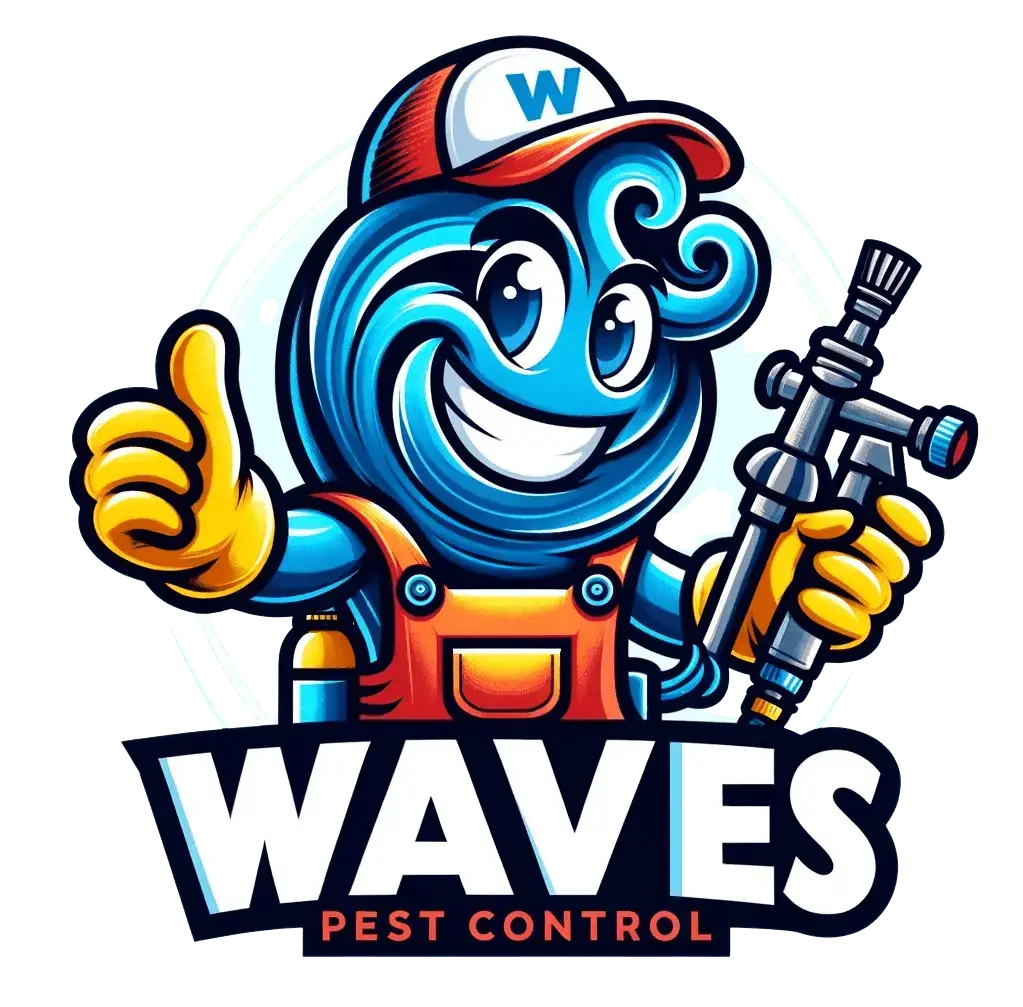
Protect Your Home from Drywood Termites!
Trust Waves Pest Control for expert drywood termite control in Bradenton, FL. Call now or request your free inspection online!
Request an InspectionPrevention Strategies for Bradenton Homeowners
Preventing drywood termite infestations is more cost-effective than treating them, and Bradenton’s climate makes ongoing prevention essential.
Structural Prevention
- Seal entry points: Use caulk, expandable foam, or other sealants to close gaps around windows, doors, vents, and utility penetrations.
- Maintain paint and finishes: Keep all exterior wood properly painted or sealed to prevent termite entry through small cracks.
- Screen vents and openings: Install fine mesh screens over attic vents, crawl space openings, and other potential entry points.
- Regular roof maintenance: Keep shingles, gutters, and roof trim in good repair to prevent moisture damage and entry points.
Landscape and Environmental Prevention
- Wood-to-soil contact: Eliminate contact between wooden structures and soil, including deck posts, fence posts, and siding.
- Firewood storage: Store firewood away from your home and off the ground to prevent it from becoming a termite source.
- Dead wood removal: Remove dead trees, stumps, and fallen branches from your property that could harbor termite colonies.
- Moisture control: Address moisture problems around your home that can attract termites or make wood more vulnerable.
Regular Monitoring and Maintenance
- Annual inspections: Have your home professionally inspected annually for termite activity, especially if you’ve had previous infestations.
- Self-monitoring: Learn to recognize early signs and check vulnerable areas regularly.
- Documentation: Keep records of treatments, inspections, and any termite activity to track patterns and inform future decisions.
- Professional relationships: Establish relationships with qualified pest control professionals who understand Bradenton’s specific termite challenges.
Choosing Professional Help in Bradenton
Drywood termite treatment requires specialized knowledge and equipment, making professional selection crucial for effective treatment.
What to Look for in Bradenton Termite Professionals
- Local experience: Choose companies with extensive experience treating drywood termites specifically in Southwest Florida’s climate.
- Licensing and certification: Verify proper state licensing and certification for termite treatment and fumigation services.
- Treatment options: Look for companies that offer multiple treatment approaches and can recommend the best option for your specific situation.
- Warranties and guarantees: Understand what warranties are offered and what they cover.
- References and reviews: Check local references and online reviews from other Bradenton homeowners.
Questions to Ask Potential Treatment Companies
Inspection and assessment:
- What does your inspection process include?
- How do you determine the extent of infestation?
- Do you provide detailed written reports?
Treatment recommendations:
- Why do you recommend this treatment method?
- What are the alternatives and their pros/cons?
- How long will treatment take?
Preparation and process:
- What preparation is required on my part?
- What should I expect during treatment?
- How long before I can re-enter my home?
Follow-up and warranty:
- What follow-up inspections are included?
- What does your warranty cover and for how long?
- What are my responsibilities under the warranty?
Red Flags to Avoid
- Door-to-door sales: Legitimate termite companies in Bradenton typically don’t use high-pressure door-to-door sales tactics.
- Immediate treatment pressure: Reputable companies will provide time for you to consider treatment options and get second opinions.
- Unusually low prices: Extremely low prices often indicate shortcuts in treatment or hidden costs.
- No written estimates: All treatment recommendations and costs should be provided in writing.
- Unlicensed operators: Always verify licensing and insurance before allowing any treatment work.
The Economics of Drywood Termite Management in Bradenton
Understanding the financial aspects of drywood termite prevention and treatment helps homeowners make informed decisions.
Prevention Costs vs. Treatment Costs
Annual prevention costs:
- Professional inspections: $100-300 annually
- Preventive treatments: $300-800 for targeted areas
- Maintenance and sealing: $200-500 annually
Treatment costs:
- Localized treatments: $500-2,000 per affected area
- Whole-house fumigation: $3,000-8,000 depending on home size
- Structural repairs: $2,000-20,000+ depending on damage extent
Long-term financial benefits of prevention:
- Avoiding major structural repairs
- Maintaining property value
- Reducing insurance and liability risks
- Peace of mind and reduced stress
Insurance and Warranty Considerations
- Homeowner’s insurance: Most policies don’t cover termite damage, making prevention and early treatment crucial for financial protection.
- Treatment warranties: Professional treatments often include warranties, but understand coverage limitations and requirements.
- Property value protection: Regular termite prevention and treatment records can actually enhance property value by demonstrating proactive maintenance.
When to Act: Decision Points for Bradenton Homeowners
Immediate Action Required
- Visible swarmer termites indoors: Any winged termites found inside your home indicate an active infestation requiring immediate professional assessment.
- Active frass production: Fresh frass appearing regularly indicates an active, growing infestation that will worsen without treatment.
- Structural concerns: Any signs of wood damage that might affect structural integrity require immediate professional evaluation.
- Real estate transactions: If you’re buying or selling, termite inspections and clearances are essential parts of the process.
Professional Consultation Recommended
- Suspicious signs: Any combination of potential termite signs (frass, holes, hollow sounds) warrants professional inspection.
- Previous infestations: Homes with termite history should have regular professional monitoring.
- High-risk situations: Older homes, homes with extensive wood construction, or homes in areas with known termite activity.
- Peace of mind: If you’re concerned about termites, professional inspection is relatively inexpensive compared to potential damage costs.
Living with Termite Reality in Bradenton
For Bradenton homeowners, drywood termites aren’t a question of “if” but “when” and “how prepared are you?” Understanding this reality helps you approach termite management proactively rather than reactively.
- Accept the ongoing nature of the threat: Bradenton’s climate means termite pressure is constant, making ongoing vigilance necessary.
- Invest in prevention: The cost of prevention is always less than the cost of treatment and repair.
- Build professional relationships: Establish connections with qualified pest control professionals before you need emergency treatment.
- Stay educated: Understanding termite biology and behavior helps you recognize problems early and make informed decisions.
- Document everything: Keep records of inspections, treatments, and any termite activity to track patterns and inform future decisions.
Frequently Asked Questions (FAQs)
How do drywood termites get into homes in Bradenton?
They typically enter through small gaps in roof areas, around windows and doors, and through damaged wood surfaces. They can fit through openings as small as 1/32 inch and often target upper areas of homes first.
What’s the difference between drywood and subterranean termites?
Drywood termites live entirely within wood without soil contact, while subterranean termites live underground and build mud tubes to reach wood. Drywood termites are harder to detect because they don’t leave external signs like mud tubes.
How quickly do drywood termites cause damage?
Drywood termite colonies develop slowly, often taking years to cause significant structural damage. However, damage can be extensive by the time it’s detected because they work internally without obvious external signs.
Can I treat drywood termites myself?
DIY treatments are generally ineffective for drywood termites due to their hidden locations and the need for specialized equipment and materials. Professional treatment is strongly recommended for effective control.
How often should I have my Bradenton home inspected for termites?
Annual professional inspections are recommended, with more frequent inspections if you’ve had previous termite problems or live in a high-risk area.
What should I do if I find winged termites in my home?
Contact a professional pest control company immediately for identification and assessment. Winged termites indoors typically indicate an active infestation that requires prompt treatment.
How much does fumigation cost in Bradenton?
Fumigation costs vary based on home size and complexity but typically range from $3,000-8,000. While expensive, it’s often less costly than extensive structural repairs from untreated infestations.
Are drywood termites active year-round in Bradenton?
Yes, Bradenton’s warm climate allows drywood termites to remain active throughout the year, unlike colder climates where activity slows seasonally.

